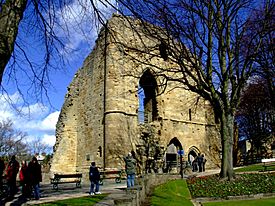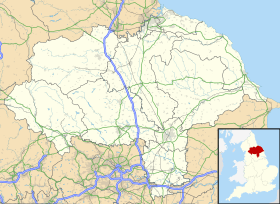Knaresborough Castle facts for kids
Quick facts for kids Knaresborough Castle |
|
|---|---|
| Knaresborough, North Yorkshire, England | |

The ruins of the keep of Knaresborough Castle.
|
|
| Coordinates | 54°00′26″N 1°28′10″W / 54.00719°N 1.46932°W |
| Type | Castle |
| Site information | |
| Owner | Duchy of Lancaster |
| Controlled by | North Yorkshire Council |
| Open to the public |
Yes |
| Condition | Ruined |
| Site history | |
| Built | Around 1100, rebuilt 1301–1307 |
| In use | Until 1648 |
Knaresborough Castle is an old fortress that now stands in ruins. It looks out over the River Nidd in the town of Knaresborough, North Yorkshire, England. This historic castle has a long and exciting past, from its early days as a Norman stronghold to its role in royal history.
Contents
A Look Back: Castle History
Early Days and Royal Connections
Knaresborough Castle was first built around the year 1100. A Norman baron chose a great spot for it, high up on a cliff above the River Nidd. We know that King Henry I had work done on the castle in 1130.
Later, in the 1170s, a group led by Hugh de Moreville hid here. They were seeking safety after being involved in the assassination of Thomas Becket, a very important church leader.
King John and Castle Improvements
In 1173, William de Stuteville became the castle's governor. After he passed away in 1203, King John took control of Knaresborough Castle. The King saw it as a very important fortress in the north of England. He spent a lot of money, about £1,290, to make the castle even better.
In 1304, Elizabeth of Rhuddlan, one of King Edward I's daughters, visited the castle. She gave birth to her son, Humphrey, there in September.
Rebuilding and Royal Ownership
The castle was rebuilt between 1307 and 1312. This big project cost £2,174 and included building the large keep. King Edward I started the work, and his son, Edward II, finished it. Edward II later gave the castle to his friend, Piers Gaveston.
In 1331, Philippa of Hainault, who was queen at the time, took over the castle. It then became a royal home. The queen and her family often spent their summers enjoying the castle. Her son, John of Gaunt, gained ownership in 1372. This added the castle to the huge lands of the Duchy of Lancaster.
Civil War and Destruction
A detailed check of the castle buildings was done in 1561. The castle was used by people who managed the royal estates. Law courts were also held in its great hall.
During the English Civil War, in 1644, soldiers loyal to Parliament took the castle. In 1648, Parliament ordered many Royalist castles to be taken apart. Knaresborough Castle was largely destroyed, not by fighting, but by this order. Many buildings in the town center today are made from stones taken from the castle.
Knaresborough Castle Today
Visiting the Ruins
The remains of Knaresborough Castle are open for everyone to visit. There is a small fee to go inside the ruined parts. The castle grounds are a popular public space. You can find a bowling green and a putting green there in the summer.
Events and Management
The castle grounds are also used for performances and events. For example, it hosts the annual FEVA (Festival of Visual Arts and Entertainment). The monarch owns the property as part of the Duchy of Lancaster. However, the North Yorkshire Council manages it for daily operations.
Castle Features
Layout and Keep
The castle, though mostly in ruins, had two main walled areas called baileys. One bailey was closer to the town, and the other was on the cliff side. Strong towers were built along the castle walls. Two of these towers, which you can still see, formed the main gate.
At the point where the two baileys met, on the north side, stood a tall, five-sided keep. A keep was the strongest and most important tower in a castle. The eastern parts of Knaresborough's keep have been pulled down. The keep had a basement with a vaulted ceiling and at least three floors above it. It served as the home for the castle's lord throughout its history.
The Courthouse Museum
The old courthouse building on the castle grounds was built in the 14th century. It was likely used to keep important records. Today, it is a museum. The building was made bigger in the 16th and 18th centuries. It was also repaired in 1830 and again in the 20th century.
The museum has furniture from the original Tudor Court. It also has exhibits about the castle and the town. The building is made of magnesian limestone and brick. It has two floors and five sections, with an extension at the back. Inside, you can see a 14th-century fireplace and 17th-century cupboards.
The Old Prison
Next to the courthouse is a former prison, built in 1786. This prison was later used for other purposes. It is made of gritstone and has a hipped stone slate roof. It has one floor with cells below. On the front, there is a window with three sections. The prison is also considered a historic building.



